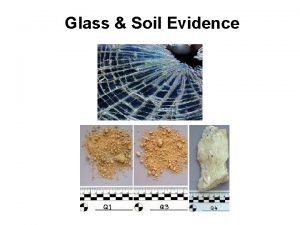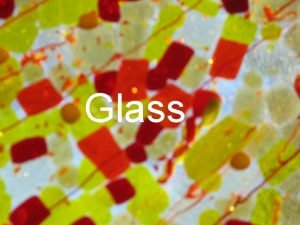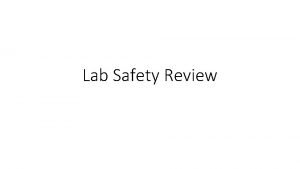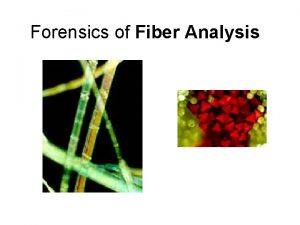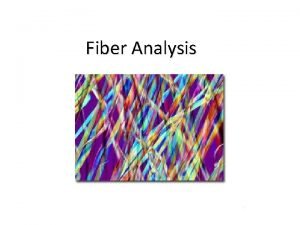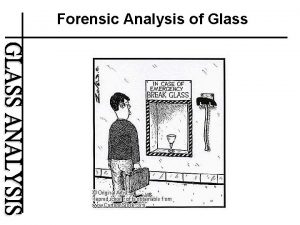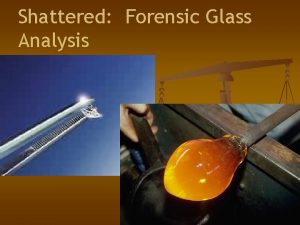GLASS ANALYSIS Forensic SciencePrice HOW GLASS IS MADE












- Slides: 12

GLASS ANALYSIS Forensic Science-Price

HOW GLASS IS MADE: https: //www. youtube. com/watch? v=Ij. Nus. HQOh. TM https: //www. youtube. com/watch? v=p. WZEw. SQl. L 88&index =10&list=PLxz. BK 3 jp 20 D 46 KGEXZ 1 K 7 z. Jp. FGMLt. Ylrk

HOW IS GLASS USED IN THE FORENSICS DEPARTMENT? Glass can be used to help determine the cause in automobile accidents. Glass can be analyzed at break in’s to find possible prints or hair to analyze. Glass can be used to determine if shots are fired, from which direction they are fired or even which shot was fired first if there are multiple shots. Also glass tends to be a good source of trace evidence if stepped in.

COMPOSITION OF GLASS: Glass- is a hard, brittle, amorphous material. Amorphous- meaning without shape or form… its particles are arranged in a random fashion. Glass is made by melting sand, lime(Ca. O) and Sodium Oxide (Na 2 O) at very high temperatures. Also Silicone Dioxide (Si. O 2) is inside the making of glass. The main ingredient is sand.

TYPES OF GLASS: The most common type of glass is Soda Lime glass. Leaded glass- which is used for decorative art & fine glassware is a crystal kind of glass. In leaded glass the Calcium Oxide (Ca. O) ingredient is replaced with (Pb. O) a lead oxide ingredient. This results in a denser glass and it gives a sparkling effect. Tempered Glass- glass which is also known as safety glass. It is inexpensive and easy to melt and shape and reasonably strong. It is commonly used in windshields and the side rear windows of cars and is composed of 2 layers of glass bonded together by a layer of plastic in the middle. This is also referred to as a treated glass that should not shatter. It is strengthened by introducing stress through rapid heating and cooling of its surface. Obsidian- volcanic glass.

DENSIT Y Each type of glass has a density… A density that is specific to the certain type of glass. Density comparison is used in the forensics field frequently. Density can be determined through the process of flotation. Density is calculated using the ratio of the mass of an object to its volume. Density and refractive index are the best comparison tools in glass analysis. More Dense… meaning closer compacted in substance. . thicker. . heavier.

REFRACTIVIT Y: The refractive index is the measure of how light bends as it passes from one substance to another. This is why objects appear bent or distorted underwater Every liquid has its own refractive index number If a piece of glass is placed in a liquid with a different refractive index an outline of the glass will be clearly visible This line is known as the Becke Line is the line created as refracted light becomes concentrated around the edges of a glass fragment. (the halo)

GLASS FRACTURE PATTERNS: Glass It has a certain degree of elasticity breaks when its elastic limit is exceeded The elasticity can also produce fractures when it is penetrated by a projectile (ex: bullet)

REFRACTIVITY CONT. When light passes through a piece of glass placed in a liquid with the same refractive index. The glass bends light at the same angle as the liquid The Becke Line disappears making the glass seem to “disappear”.

Radial Produced first Always forms on the side of the glass opposite to where the impact originated Looks like spider webs that spread outward from the impact hole Appears when the lines radiate from the point of impact. Concentric TYPES OF FRACTURE S: Produced after radial Encircles the bullet hole Always starts on the same side as that of the destructive force A crack in a circular pattern

SEQUENCE OF IMPACT: When determining the sequence of multiple bullet holes… The radial fractures from the second bullet hole will always terminate into the fractures from the first bullet hole. The radial fractures from a third bullet will terminate into the radial fractures from the second bullet, and so forth.

DETERMINING DIRECTION: When determining the direction from which a bullet was fired… Compare the size of the entrance hole to the size of the exit hole …Exit holes are always larger, regardless of the type of material that was shot A larger piece of glass is knocked out of the surface where the bullet is leaving because glass is elastic and bows outward when struck.
 Glass forensic science
Glass forensic science Radial lines glass
Radial lines glass Forensic pathologist vs forensic anthropologist
Forensic pathologist vs forensic anthropologist Forensic psychiatry vs forensic psychology
Forensic psychiatry vs forensic psychology Glass evidence in forensic science
Glass evidence in forensic science What is glass
What is glass Glass ceiling glass escalator
Glass ceiling glass escalator If acid is splashed on your skin wash at once with
If acid is splashed on your skin wash at once with Does hot glass look like cold glass
Does hot glass look like cold glass Forensic handwriting analysis video
Forensic handwriting analysis video Fibers forensics
Fibers forensics Tire impressions
Tire impressions Fibers from animals
Fibers from animals




